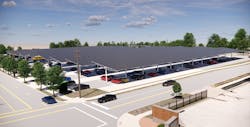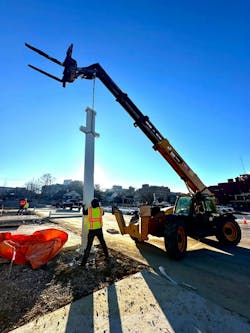Going Wild for Renewables: Cincinnati Zoo Breaks Ground on New Solar Plus Storage Microgrid
The Cincinnati Zoo & Botanical Garden has broken ground on a 2.8-MW solar array at its Euclid Avenue parking lot. Zoo officials say that once completed, the array will be the largest publicly accessible urban solar array in the U.S.
The array, which is being erected as solar canopies over the parking lot, will provide shade for cars and buses.
The system will also include a large battery energy storage system and microgrid controls.
On the path to net zero
This is not the zoo’s first foray into renewable energy. In 2006, a 20-kW rooftop solar array was installed on the zoo’s education center. That was followed by a 1.56-MW solar array at the zoo’s main parking lot in 2011.
According to a statement from the zoo, the investments in solar have paid off with the zoo having “many days ‘off grid’” since the original parking lot array came online.
With the addition of the Euclid Avenue installation, the zoo expects to have 4.55 MW of on-site solar capacity by the end of the year, putting it well on the way to achieving its goal of being net zero by 2025.
“Solar technology, and our understanding of how to use it, has evolved dramatically since we erected our first solar array in 2006 on the zoo’s education building,” said Mark Fisher, vice president of facilities and sustainability for the Cincinnati Zoo. “This new array is a good example of that. It will occupy less physical space but will generate almost twice as much power as the current array. Once it’s online, two-thirds of the zoo’s electrical needs will come from our parking lots.
The zoo has also leased 125 acres of its 600-acre farm located northeast of the Cincinnati metro area to Harrison Street, a power producer. Harrison Street is in the process of constructing a 30-MW array on the land that, when completed later this year, will be one of the largest arrays in Southwest Ohio. The zoo will receive an annual lease payment for the duration of the 40-year agreement, and the energy generated by the array will be sold to companies in the region.
Nearly 800 grazing sheep, nature’s lawnmowers, will be brought to the farm this spring to keep the soil healthy and the grass and weeds in check.
Zoos going green
Cincinnati’s zoo isn’t the only zoological organization investing heavily in clean energy. The San Diego Zoo is home to a microgrid powered by 10 solar canopies generating 90 kW of electricity. The system, which was completed in 2011, powers five electric vehicle charging stations.
Paying it forward
As part of its latest solar initiative, the Cincinnati Zoo is donating solar panels to its Community Solar Resiliency Program (CSRP), which works to improve the energy, climate and financial resilience of community organizations in the Greater Cincinnati area. CSRP aims to install at least one solar plus storage energy system in the community each year.
Rather than paying to ship the exact number of panels needed for the Euclid Avenue location, which would have resulted in half-empty crates arriving at the site, the zoo ordered 165 kW of extra panels to fill those crates. The extras will be used by the CSRP in three different arrays in the Avondale, East Price Hill and Bond Hill neighborhoods of Cincinnati.
To date, the CSRP has installed 68 kW of solar at four different locations around Cincinnati, including a 13-kW array at the John P. Parker Elementary School that was erected last year.
“Our goal is to share the benefits of solar power with the community,” said Fisher. “In addition to providing power and building smaller arrays at churches, community centers and schools around town, our hope is that just seeing, and parking under, our big arrays will inspire zoo visitors to install solar panels at home.”
The zoo is also partnering with the South Rift Association of Land Owners in Kenya, Africa, on a solar array to be installed later this year. The array will provide renewable energy for the community.









